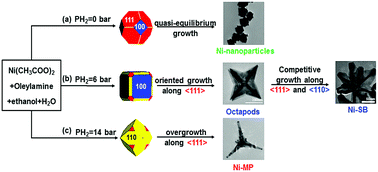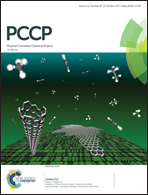Hydrogen assisted synthesis of branched nickel nanostructures: a combined theoretical and experimental study†
Abstract
The selective adsorption of small molecules over specific facets plays an important role in morphology controlled synthesis of metal nanocrystals. In the present work, hydrogen is found to be a good capping agent for direct synthesis of branched nickel nanocrystals, i.e., secondary branching (Ni-SB) nanoparticles and multipods (Ni-MP). Using ab initio thermodynamics and the Wulff construction principle, it has been found that: (i) in the presence of hydrogen (PH2 = 6 bar), the facet structure stability follows the order of Ni(100) > Ni(111) > Ni(110), resulting in competitive over-growth along the 〈111〉 and 〈110〉 directions; (ii) with increasing hydrogen pressure, the Ni deposition rate over the crystal surface increases as a result of more Ni2+ reduction; the competition between deposition and surface diffusion, therefore, becomes the vital factor for the nanocrystal growth process; (iii) the diffusion energy barrier of a surface Ni atom on Ni(111) is lower than that on Ni(110), especially on hydrogen covered surfaces, indicating that the kinetic over-growth only along the 〈111〉 direction producing Ni-MP will be dominant under PH2 = 14 bar; (iv) the ab initio based Wulff construction principle predicts the shapes and morphologies at different hydrogen pressures which is further confirmed with HRTEM results. Finally, compared with nickel nanoparticles (Ni-NP) synthesized in the absence of hydrogen, the hydrogen assisted branched Ni nanomaterials, especially the Ni-MP, show higher catalytic activities for hydrogenation reactions of acetophenone and nitrobenzene.



 Please wait while we load your content...
Please wait while we load your content...